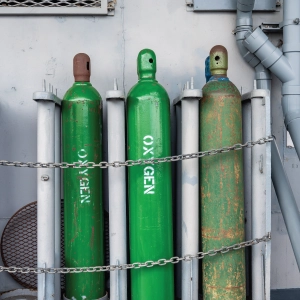Recordkeeping Requirements for Hazardous Waste Generators
Generating Hazardous Waste?
Know the Recordkeeping Requirements that must be Followed According to the RCRA.
.webp)
All employers must safeguard the health of individuals exposed to or handling hazardous waste. To instill greater diligence in this regard, the U.S. Environmental Protection Agency (EPA) under the Resource Conservation and Recovery Act (RCRA) has developed and implemented a set of rules and regulations that must be complied with.
One part of these rules and regulations is the need for recordkeeping. Recordkeeping requirements, like training requirements, differ according to the amount of waste generated and accumulated on-site. As such large quantity generators (LQGs), small quantity generators (SQGs), and very small quantity generators (VSQGs) must strictly adhere to the RCRA recordkeeping requirements, as applicable.
Take a look at the summarized table of recordkeeping requirements for LQGs, SQGs, and VSQGs.
What Types of Recordkeeping are Required by the RCRA?
All sizes of waste generators can benefit from keeping proper and detailed records, However, the larger the amounts of hazardous waste being handled, the more stringent the recordkeeping requirements. As such, the RCRA gives detailed guidance on recordkeeping requirements for hazardous waste generator facilities.
According to the RCRA regulations regarding recordkeeping, organizations that generate hazardous waste categorized as LQGs are required to fulfill all eight (8) types of documentation obligations explained below. However, SQGs are expected from preparing biennial reports, resulting in the need for only seven (7) types of recordkeeping requirements to be fulfilled.
Let’s discuss these recordkeeping requirements in detail:
1. Employee training records
Hazardous waste personnel at LQGs must receive initial and annual re-training, as per the regulations (262.17(a)(7)(iv)), and these training sessions must be documented. Training records for current personnel must be maintained by generators until the facility is closed. For former employees, the training records must be kept for a minimum of three years from their last day of work at the facility.
According to 40 CFR Part 262.17(a)(7)(v), the following records pertaining to training must be maintained by large quantity generators:
- Job titles for positions related to hazardous waste.
- Names of employees holding these positions.
- Written job descriptions with specific information.
- Written descriptions of the type and amount of training provided.
- Documentation confirming successful completion of the training, such as a certificate of training.
2. Waste classification records
Maintaining complete and accurate waste determination records is crucial to keep track of the composition of the waste, its origin, applicable treatment standards, and potential exclusions. These records can also serve as proof of the waste's characteristics. Regardless of whether the material is classified as hazardous waste, non-hazardous waste, or recyclable or reusable material, LQGs must document how this waste was classified and maintain those records.
According to 40 CFR Part 262.11(f), the following details must be recorded about the waste determination process:
- Results of any tests, sampling, analyses, or other determinations.
- Documentation of the methods used for the tests, sampling, analyses, etc.
- Records showing the process that generated the waste.
- The waste's composition and properties.
- All relevant waste codes, such as D001, D002, F003, etc.
All such waste determination records must be retained by generators for a minimum of three years following the last instance of sending the waste for treatment, storage, or disposal.
3. Hazardous waste manifests
In the United States, the Uniform Hazardous Waste Manifest is utilized as a means of monitoring the transportation of hazardous waste. Once a generator has received a signed copy from the receiving facility (i.e., a treatment, storage, and disposal facilities (TSDF)), that particular copy must be preserved as a record for a minimum of three years from the date on which the waste was accepted by the initial transporter. During the interim period while waiting for the receiving facility to return a copy of the Manifest, generators are advised to maintain a copy for their records in the event of discrepancies or other complications.
To align with the increasingly tech-savvy world and transition to paperless systems and processes, the EPA launched the electronic manifest (e-Manifest) option for hazardous waste generators on June 30, 2018. For more information about the e-manifest systems, click here.
Remember that hazardous waste manifests must be signed by an authorized person, and he or she must receive the proper training to do so!
4. Hazardous waste contingency plan
Large quantity generators are required to have an RCRA contingency plan to ensure that emergency responders and personnel have access to accurate and current information to guide their emergency response efforts. Additionally, LQGs must create a quick reference guide for their contingency plan that includes eight (8) specific elements. The contingency plan must be updated or amended immediately in the event of changes to regulations, a failure of the plan during an emergency, facility modifications, a change in emergency coordinators, or modifications to the list of emergency equipment.
The regulations governing the purpose, content, and distribution of written contingency plans can be found in 40 CFR Part 262, Subpart M.
5. Hazardous Waste Incident Reports
If an incident involving hazardous waste necessitates the activation of the contingency plan, the generator is required to document the event's date, time, and specifics. Additionally, within 15 days of the incident, the generator must submit a written report of the incident to the regional EPA administrator.
This incident report should include the following details:
- Name, address, and telephone number of the generator.
- Date, time, and type of incident (e.g., fire, explosion).
- Name and quantity of the hazardous material(s) involved.
- Information about injuries, if any.
- An assessment of actual or potential hazards, where applicable.
- Estimated quantity and disposition of the recovered material resulting from the incident.
6. Land Disposal Restrictions (LDR) Documentation
The RCRA regulations establish a hazardous waste management system from the point of generation to final disposal, known as cradle-to-grave. Even after the hazardous waste is disposed of, records pertaining to compliance with land disposal restrictions must be retained. Hazardous waste generators are required to keep copies of LDR-related records for a minimum of three years after the waste is sent for treatment, storage, or disposal.
The Land Ban Form, Compliance Certifications, One-time Notice to File, and Waste Analysis Plans are some of the documents that must be prepared by hazardous waste generators. For more information about these LDR recordkeeping documents, refer to 40 CFR Part 268.7(a).
7. Records for Tank and Central Storage Area Inspections
Hazardous waste generators are required to regularly inspect the tank and central storage areas as per the 40 CFR Parts 262 and 265. The regulations also mandate recordkeeping of the daily tank inspections. Keeping records of the weekly storage area inspections is not explicitly required by the regulations, but it is considered a best management practice as it provides evidence that the generator has met the inspection requirements.
The facility should retain tank inspection records until it ceases operation. Additionally, according to 40 CFR Parts 265.191(a) and 192(a) and (g), LQGs are required to keep an engineer's evaluation of the storage tank system's integrity until the facility closes.
8. The Biennial Report
According to Federal hazardous waste regulations, LQGs are required to submit a Biennial Report every even-numbered year (2024, 2026, etc.) by March 1st. This report must detail the type, quantity, and disposition of hazardous waste(s) generated or stored during the previous year. Additionally, according to 40 CFR Part 262.40(b), hazardous waste generators are required to keep a copy of their biennial report for at least three years after the due date.
As part of the Biennial Report (EPA Form 8700-13A/B), generators are required to provide specific details, such as:
- The EPA ID number of the facility,
- The name and address of the facility,
- The quantity and type of hazardous waste generated, and
- Whether the hazardous waste was sent for recycling, treatment, storage, or disposal.
It should be noted that state-level regulations may vary, as the EPA allows most states to establish and implement additional, more stringent requirements for hazardous waste generators within their jurisdiction. For example, some states may mandate LGQ to submit an annual report rather than a biennial report.
Also note, that small quantity generators are not required to submit a biennial report, although preparing one is considered a good and safe work practice!
Training Requirements According to the RCRA
While recordkeeping is important when generating hazardous waste, equally important is the need to provide training to employees and other workers involved in handling hazardous waste in organizations across all types of industries that produce hazardous waste. Thus, employers must provide RCRA Training to workers in their facilities to comply with regulations and protect the health of workers. This requires both RCRA initial training when starting the job role and RCRA annual refresher training thereafter.
Additionally, any organization involved in the treatment, storage, and disposal of hazardous waste must train employees according to the HAZWOPER standards.

 EN |
EN |  ES
ES






























































































































